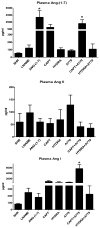Angiotensin-(1-7) blockade attenuates captopril- or hydralazine-induced cardiovascular protection in spontaneously hypertensive rats treated with NG-nitro-L-arginine methyl ester
- PMID: 21326110
- PMCID: PMC3095755
- DOI: 10.1097/FJC.0b013e31821324b6
Angiotensin-(1-7) blockade attenuates captopril- or hydralazine-induced cardiovascular protection in spontaneously hypertensive rats treated with NG-nitro-L-arginine methyl ester
Abstract
We assessed the contribution of angiotensin-(1-7) [Ang-(1-7)] to captopril-induced cardiovascular protection in spontaneously hypertensive rats (SHRs) chronically treated with the nitric oxide synthesis inhibitor NG-nitro-L-arginine methyl ester (SHR-l). NG-nitro-L-arginine methyl ester (80 mg/L) administration for 3 weeks increased mean arterial pressure (MAP) from 196 ± 6 to 229 ± 3 mm Hg (P < 0.05). Treatment of SHR-l with Ang-(1-7) antagonist [d-Ala7]-Ang-(1-7) (A779; 744 μg·kg(-1)·d(-1) ip) further elevated MAP to 253 ± 6 mm Hg (P < 0.05 vs SHR-l or SHR). Moreover, A779 treatment attenuated the reduction in MAP and proteinuria by either captopril (300 mg/L in drinking water) or hydralazine (1.5 mg·kg(-1)·d(-1) ip). In isolated perfused hearts, the recovery of left ventricular function from global ischemia was enhanced by captopril or hydralazine treatment and was exacerbated with A779. The Ang-(1-7) antagonist attenuated the beneficial effects of captopril and hydralazine on cardiac function. Recovery from global ischemia was also improved in isolated SHR-l hearts acutely perfused with captopril during both the perfusion and reperfusion periods. The acute administration of A779 reduced the beneficial actions of captopril to improve recovery after ischemia. We conclude that during periods of reduced nitric oxide availability, endogenous Ang-(1-7) plays a protective role in effectively buffering the increase in blood pressure and renal injury and the recovery from cardiac ischemia. Moreover, Ang-(1-7) contributes to the blood pressure lowering and tissue protective actions of captopril and hydralazine in a model of severe hypertension and end-organ damage.
Figures





Similar articles
-
Angiotensin-(1-7) prevents development of severe hypertension and end-organ damage in spontaneously hypertensive rats treated with L-NAME.Am J Physiol Heart Circ Physiol. 2006 Feb;290(2):H684-91. doi: 10.1152/ajpheart.00632.2005. Am J Physiol Heart Circ Physiol. 2006. PMID: 16403946
-
Endogenous angiotensin-(1-7) reduces cardiac ischemia-induced dysfunction in diabetic hypertensive rats.Pharmacol Res. 2009 Apr;59(4):263-8. doi: 10.1016/j.phrs.2008.12.008. Epub 2008 Dec 31. Pharmacol Res. 2009. PMID: 19166939 Free PMC article.
-
Effects of dipeptidyl peptidase iv inhibition on arterial blood pressure.Clin Exp Pharmacol Physiol. 2008 Jan;35(1):29-34. doi: 10.1111/j.1440-1681.2007.04737.x. Clin Exp Pharmacol Physiol. 2008. PMID: 18047624
-
Contribution of cytochrome P450 1B1 to hypertension and associated pathophysiology: a novel target for antihypertensive agents.Prostaglandins Other Lipid Mediat. 2012 Aug;98(3-4):69-74. doi: 10.1016/j.prostaglandins.2011.12.003. Epub 2011 Dec 20. Prostaglandins Other Lipid Mediat. 2012. PMID: 22210049 Free PMC article. Review.
-
Protective importance of the myogenic response in the renal circulation.Hypertension. 2009 Aug;54(2):393-8. doi: 10.1161/HYPERTENSIONAHA.109.133777. Epub 2009 Jun 22. Hypertension. 2009. PMID: 19546375 Free PMC article. Review. No abstract available.
Cited by
-
Dipeptidyl peptidase 3, a marker of the antagonist pathway of the renin-angiotensin-aldosterone system in patients with heart failure.Eur J Heart Fail. 2021 Jun;23(6):947-953. doi: 10.1002/ejhf.2158. Epub 2021 Mar 30. Eur J Heart Fail. 2021. PMID: 33742751 Free PMC article.
-
Influence of antihypertensive drugs on aortic and coronary effects of Ang-(1-7) in pressure-overloaded rats.Braz J Med Biol Res. 2017 Mar 23;50(4):e5520. doi: 10.1590/1414-431X20165520. Braz J Med Biol Res. 2017. PMID: 28355350 Free PMC article.
-
Targeting the epidermal growth factor receptor (EGFR/ErbB) for the potential treatment of renal pathologies.Front Pharmacol. 2024 Aug 21;15:1394997. doi: 10.3389/fphar.2024.1394997. eCollection 2024. Front Pharmacol. 2024. PMID: 39234105 Free PMC article. Review.
-
Differences in angiotensin (1-7) between men and women.Am J Physiol Heart Circ Physiol. 2015 May 1;308(9):H1171-6. doi: 10.1152/ajpheart.00897.2014. Epub 2015 Feb 6. Am J Physiol Heart Circ Physiol. 2015. PMID: 25659489 Free PMC article.
-
Predominance of AT(1) blockade over mas-mediated angiotensin-(1-7) mechanisms in the regulation of blood pressure and renin-angiotensin system in mRen2.Lewis rats.Am J Hypertens. 2013 May;26(5):583-90. doi: 10.1093/ajh/hps090. Epub 2013 Mar 4. Am J Hypertens. 2013. PMID: 23459599 Free PMC article.
References
-
- Chappell MC. Emerging evidence for a functional angiotesin-converting enzyme 2-angiotensin-(1-7) mas receptor axis; more than regulation of blood pressure? Hypertension. 2007;50(4):596–599. - PubMed
-
- Ferrario CM. Angiotensin-converting enzyme 2 and angiotensin-(1-7): an evolving story in cardiovascular regulation. Hypertension. 2006;47(3):515–521. - PubMed
-
- Santos RA, Ferreira AJ, Simoes e Silva AC. Recent advances in the angiotensin-converting enzyme 2-angiotensin(1-7)-Mas axis. Exp Physiol. 2008;93(5):519–527. - PubMed
-
- Shaltout HA, Westwood B, Averill DB, Ferrario CM, Figueroa J, Diz DI, Rose JC, Chappell MC. Angiotensin metabolism in renal proximal tubules, urine and serum of sheep: Evidence for ACE2-dependent processing of Angiotensin II. Am J Physiol Renal Physiol. 2006;292:F82–F91. - PubMed
-
- Allred AJ, Diz DI, Ferrario CM, Chappell MC. Pathways for angiotensin-(1-7) metabolism in pulmonary and renal tissues. Am J Physiol. 2000;279(5):F841–F850. - PubMed
Publication types
MeSH terms
Substances
Grants and funding
LinkOut - more resources
Full Text Sources
Medical
Miscellaneous

